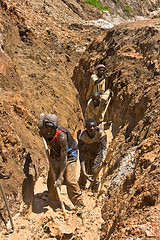
Over the past three years, teams of business persons, government officials, and civil society members have been traveling to mines in eastern Democratic Republic of Congo to assess whether or not the mines are conflict-free. In order to pass, mines must be found to be free of the presence of armed groups including the Congolese army, and free of harmful forms child labor or labor by pregnant women. Spurred by the Dodd-Frank 1502 legislation on conflict minerals, this process is Step 1 of the Great Lakes regional minerals certification process, also known as the Regional Certification Mechanism (RCM) of the International Conference on the Great Lakes Region (ICGLR).This is the first time in Congo's history that such a process has taken place.
Funded by USAID and the German government's Federal Institute for Geosciences and Natural Resources (BGR), the teams are led by the International Organization for Migration (IOM) and include representatives from Congolese civil society, the Congolese government, business, and the United Nations.
The teams of "validation missions," as they are known, have made significant progress since they started: out of a total 180 mines assessed so far, 141 have now been validated as conflict-free. While this does not include every mine, it does cover a large percentage of the minerals trade, as many of the large mines in eastern Congo have been validated. However, the validation missions still need to travel to several other areas, including Shabunda and Walikale.
Click here to learn more about which mines are conflict-free.
Citation information for chart: Naeher.U & Nzuma.Y (2015): Summary of Joint Missions and CTC Mine Site Audits in Eastern DRC. Federal Bureau of Geosciences and Natural Ressoures (BGR), Kinshasa, June 2015.
Photo credit: Sasha Lezhnev/Enough Project

